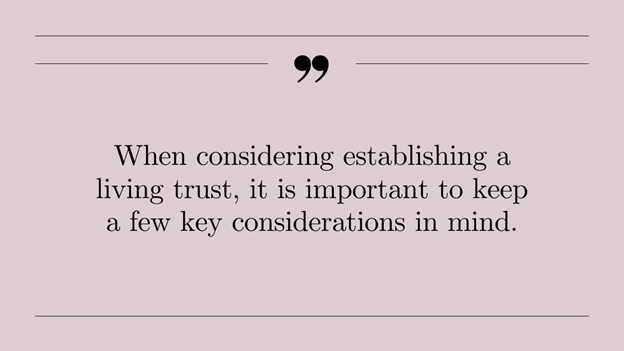
Living Trusts: Understanding the Basics and Key Considerations

Estate management can be a complex and daunting task for many people, but it’s a critical step in helping your assets get managed and distributed according to your wishes.
One popular tool that can be used in estate strategies is a living trust. A living trust can provide a flexible and efficient way to manage assets during your lifetime and after your death, but it’s important to understand how it works and whether it’s the right choice for your individual circumstances.
Using a living trust or any other type of trust involves a complex set of tax rules and regulations. Before moving forward with a trust, consider working with a professional who is familiar with these rules and regulations.
In this blog, we’ll dive into the details of living trusts, including how they differ from other types of trusts, what their benefits and limitations are, and how they can play a role in your overall estate strategy. Whether you’re just starting to consider estate tools or looking for ways to optimize your current approach, this blog is designed to provide insights to help you make more informed decisions.
What is a living trust?1
A living trust, which can either be revocable or irrevocable, is a legal agreement in which you transfer ownership of your assets into the trust while maintaining control over them. The trust becomes the owner of those assets, and you can be the trustee or choose someone else to manage the trust during your lifetime.

Please be aware that a living trust is not the same as a living will. A living will is a directive written by you that details how you prefer to receive medical treatment if you become incapacitated or lose the ability to communicate.
Does a living trust supplement or replace a will and why?
A living trust can supplement a will, but it may not entirely replace the need for a will. A living trust offers a way to manage your assets while you’re alive and after your death. But there are some assets you may not wish to place in a trust, such as automobiles or jewelry.
With a living trust, you can control how your assets are distributed after your death without going through probate court, which can be time consuming and costly.
What are the benefits of a living trust? Here are a few key benefits to consider:
- Privacy: Unlike a will, a living trust is not a public document. This means that the details of the trust and its assets can remain private.
- Flexibility: A revocable living trust can be modified or changed by the grantor during their lifetime, allowing for flexibility in estate management.
- Preparing for incapacity: A living trust in combination with other estate documents can provide instructions for the management of assets in the event that the grantor becomes incapacitated.
There are a few limitations to consider, as well:
- Complex and timely: A living trust can be more difficult to set up compared with other estate documents.
- Guardianship of children. A living trust cannot designate guardianship for minors.
- Taxes and creditors: A living trust is limited regarding the tax benefits it can provide and the protection it offers against creditors.
What is the difference between a living or revocable trust and irrevocable trust?2
The main difference between revocable and irrevocable trusts is simply that a revocable trust can be modified or revoked by the grantor during their lifetime, while an irrevocable trust cannot. An irrevocable trust is typically used for more complex estate situations, such as tax management purposes. Keep in mind that revocable trusts are commonly referred to as simply “living trusts.”
What assets can you put into a living trust?
Anything you own that has value can be added to a living trust, including real estate, personal property, and financial accounts. However, the grantor may choose to keep certain assets out of the living trust.
Assets must be assigned to a living trust to be covered by its terms. This means that they are retitled to indicate ownership by the trust.
The types of assets that can fund a trust include:3
- Real estate
- Land
- Commercial property
- Homes
- Personal property
- Jewelry
- Artwork
- Antiques
- Cars
- Closely held business interests
- Financial accounts4
- Checking and saving accounts
- Certificates of deposit
- Investment accounts
After you die, your life insurance proceeds also can flow to your trust if you named it as the beneficiary.5

When considering establishing a living trust, it is important to keep a few key considerations in mind.
- Responsibility: You must choose a trustee or co-trustee carefully. This is a major responsibility. Make sure whomever you name is willing and able to fulfill your wishes as stated in the trust.
- Ongoing maintenance: A living trust must be maintained and managed over time to account for life events and changes in your assets. Reviewing a revocable trust periodically and keeping it up-to-date may help avoid problems down the road.
How does it play a role in estate management?
A living trust can play a crucial role in estate management by providing a way to manage assets during a person’s lifetime and after their death. It can also provide flexibility in estate strategies and help avoid probate courts, saving time and money for beneficiaries.
Conclusion
In conclusion, deciding whether to establish a living trust or any other type of trust is best done by working with an estate attorney and any other professional who understands your personal finances. Seek guidance before determining the best strategy for you, as your needs can vary depending on your individual circumstances and goals.
If you want to learn more about how trusts can be used in estate strategies, please contact our office. We might have some additional information or illustrations that can show you how trusts can be structured.
1. NerdWallet.com, December 6, 2021
2. Investopedia.com, September 8, 2022
3. Investopedia.com, September 16, 2022
4. Certificates of deposit (CD) are time deposits offered by banks, thrift institutions, and credit unions. They may offer a slightly higher return than a traditional bank savings or checking account, but they may also require a higher deposit amount. If you sell before the CD reaches maturity, you may be subject to penalties.
5. Several factors will affect the cost and availability of life insurance, including age, health, and the type and amount of insurance purchased. Life insurance policies have expenses, including mortality and other charges. If a policy is surrendered prematurely, the policyholder also may pay surrender charges and have income tax implications. You should consider determining whether you are insurable before implementing a strategy involving life insurance. Any guarantees associated with a policy are dependent on the ability of the issuing insurance company to continue making claim payments.
 Secure Document Sharing
Secure Document Sharing


